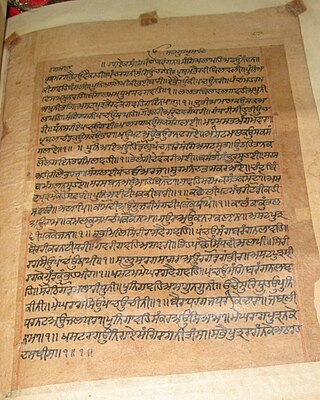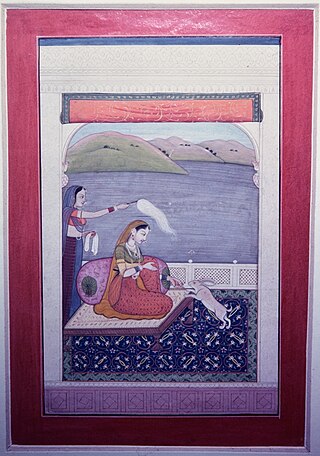
Gauri is an India musical raga that appears in the Sikh tradition from northern India and is part of the Sikh holy scripture called Sri Guru Granth Sahib. Every raga has a strict set of rules which govern the number of notes that can be used; which notes can be used; and their interplay that has to be adhered to for the composition of a tune. there are Gouris of the Bhairav, Poorvi and Marwa thats with additional qualifiers such as the Shree-anga Gouri, Bhairav-anga Gouri, Poorvi-anga Gouri and so on. These are not considered ‘big’ ragas.

Religious music is a type of music that is performed or composed for religious use or through religious influence. It may overlap with ritual music, which is music, sacred or not, performed or composed for or as ritual. Religious songs have been described as a source of strength, as well as a means of easing pain, improving one's mood, and assisting in the discovery of meaning in one's suffering. While style and genre vary broadly across traditions, religious groups still share a variety of musical practices and techniques.

The Guru Granth Sahib is the central holy religious scripture of Sikhism, regarded by Sikhs as the final, sovereign and eternal Guru following the lineage of the ten human gurus of the religion. The Adi Granth, its first rendition, was compiled by the fifth guru, Guru Arjan (1564–1606). Its compilation was completed on 29 August 1604 and first installed inside the Golden Temple in Amritsar on 1 September 1604. Baba Buddha was appointed the first Granthi of the Golden Temple. Shortly afterwards Guru Hargobind added Ramkali Ki Vaar. Later, Guru Gobind Singh, the tenth Sikh guru, added hymns of Guru Tegh Bahadur to the Adi Granth and affirmed the text as his successor. This second rendition became known as the Guru Granth Sahib and is also sometimes referred to as the Adi Granth.

Sorath is an India musical raga that appears in the Sikh tradition from northern India and is part of the Sikh holy scripture called Sri Guru Granth Sahib. Every raga has a strict set of rules which govern the number of notes that can be used; which notes can be used; and their interplay that has to be adhered to for the composition of a tune. In the Guru Granth Sahib, the Sikh holy Granth (book) there are a total of 60 raga compositions and this raga is the twenty fifth raga to appear in the series. The composition in this raga appear on a total of 65 pages from page numbers 595 to 660.

Anand Sahib is a collection of hymns in Sikhism, written in the Ramkali Raag by Guru Amar Das, the third Guru of the Sikhs. It appears on the pages 917 to 922 in Guru Granth Sahib Ji. The word Anand means complete happiness.

Sikh music, also known as Gurbani Sangeet , and as Gurmat Sangeet, or even as Shabad Kirtan, is the classical music style that is practised within Sikhism. It exists in institutional, popular, and folk traditions, forms, and varieties. Three types of Sikh musicians are rababis, ragis, and dhadhis. Sikh music exists in various melodic modes, musical forms, styles, musicians, and performance contexts.

The principal Sikh scripture is the Adi Granth, more commonly called the Guru Granth Sahib. The second most important scripture of the Sikhs is the Dasam Granth. Both of these consist of text which was written or authorised by the Sikh Gurus.

Raga Ramkali is an early morning raga in Hindustani classical music which belongs to Bhairav Thaat. In this raga, as in Bhairav, Rishabh and Dhaivat are Komal(flat), but the Teevra and the flat nishad are added. The vadi-samvadi are Pancham and Shadja. The aroha is S r G M P, G M d N S' and the avroha is S' N d P m P, d (N)d P, G M r S. Flat nishad and sharp madhyama are used often.
Raga Asa is peculiar raga of Gurmat Sangeet Tradition. It is not being used in Indian music. There is a raga 'Majh Khamaj' in Hindustani Sangeet, but it does not resemble Asa of Gurmat Sangeet. Gurmat Sangeet is a musicology of Sikh Sacred Music, used in the Sikh holy scripture the Guru Granth Sahib. The ragas used by Sikh Gurus for Gurbani are known as Gurmat Sangeet. It is popular in the Sikh tradition from northern India and is part of daily prayers being conducted in Sikh Gurdwaras. Every raga has a strict set of rules which govern the number of notes that can be used; which notes can be used; and their interplay that has to be adhered to for the composition of a tune.

This is an India musical raga (composition) that appears in the Sikh tradition from northern India and is part of the Sikh holy scripture called Sri Guru Granth Sahib or Guru Granth Sahib for short. Every raga has a strict set of rules which govern the number of notes that can be used; which notes can be used; and their interplay that has to be adhered to for the composition of a tune. In the Guru Granth Sahib, the Sikh holy Granth (book) there are a total of 31 raga compositions and this raga is the ninth raga to appear in the series. The composition in this raga appear on a total of only 2 pages from page numbers 719 to 721.

Bihagara is an Indian musical raga (composition) that appears in the Sikh tradition from northern India and is part of the Guru Granth Sahib. Every raga has a strict set of rules which govern the number of notes and their interplay that has to be adhered to for the composition of a tune. The Guru Granth Sahib consists of 60 ragas and this is the twenty-second raga to appear in the series. The composition in this raga appears from page 537 to 557.

Basant or Vasant is a Hindustani classical raga.

Bilaval or Bilawal is a raga and the basis for the eponymous thaat in Hindustani classical music. Raga Bilaval is named after Veraval, Gujarat.

Devagandhari is a raga in Indian classical music. In carnatic classical music, Devagandhari is a janya raga, whose melakarta raga is Shankarabharanam, 29th in the 72 Melakarta raga system. This is not to be confused with Karnataka Devagandhari, which is a janya of Kharaharapriya similar to Abheri.

Dhanashree is a raga. It prominently appears in the Sikh tradition from northern India and is part of the Guru Granth Sahib.

This is an India musical raga (composition) that appears in the Sikh tradition from northern India and is part of the Guru Granth Sahib. Every raga has a strict set of rules which govern the number of notes that can be used; which notes can be used; and their interplay that has to be adhered to for the composition of a tune.

Ragmala, alternatively spelt as Raagmala or Ragamala is a composition of twelve verses, running into sixty lines, that names various Raga, which appear in most saroops of Guru Granth Sahib, after the compositions of Guru Arjan entitled Mundavani

A Ragi is a Sikh musician who plays hymns (shabads) in different ragas as prescribed in the Sri Guru Granth Sahib.

Suhi, a very old North Indian raga.: it also appears in the Sikh tradition from northern India and forms part of the Guru Granth Sahib. In the Guru Granth Sahib, the composition appear in 62 ragas and this is the thirty first raga to appear in the series. The composition in this raga first appear on Ang number 728.
Jaitsri is an Indian classical raga that appears in the Sikh tradition from northern India and is part of the Guru Granth Sahib. It provided the setting for hymns by Guru Ram Das, Guru Arjan and Guru Tegh Bahadar for a total of 30 hymns.


















